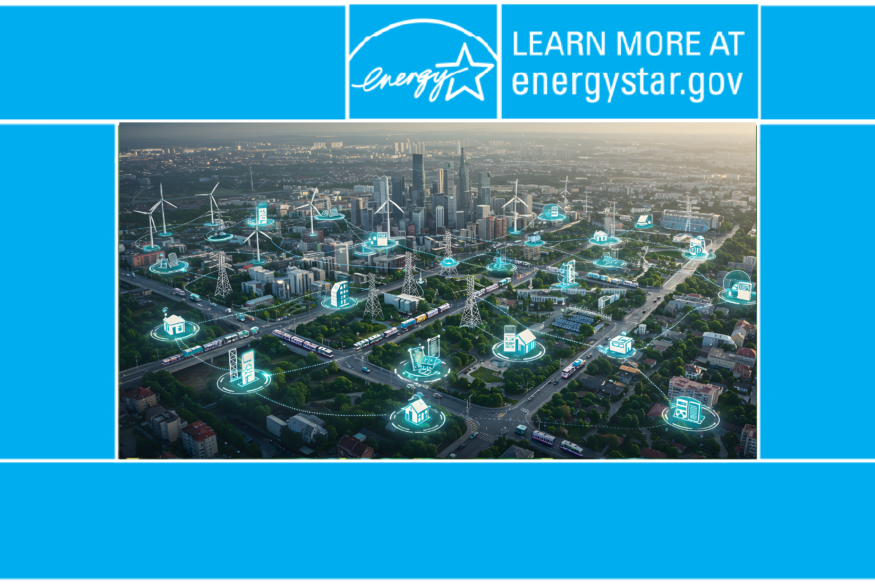ENERGY STAR at Scale: Portfolio Strategy for Multiple Buildings
Managing energy performance for one building is straightforward. Managing it across dozens or hundreds of properties requires deliberate strategy. REITs, institutional investors, and large property owners need systematic execution to achieve portfolio-wide ENERGY STAR certification. Organizations without proper infrastructure waste money and miss opportunities. Those with the right approach achieve compounding results.
Portfolio-wide certification delivers compliance advantages in markets with building performance standards, reduces operating costs at scale, enhances asset values, and provides competitive differentiation. But success requires answering key questions: which buildings to certify first, how to standardize operations, how to aggregate data efficiently, and how to allocate staff and budget.
Leading real estate companies have solved these problems. Their approaches provide a roadmap.
The Business Case for Portfolio-Scale Certification
Leading REITs prioritize portfolio-wide ENERGY STAR certification for tangible reasons. Kilroy Realty achieved certification for 53 properties and benchmarks 100% of its portfolio. Boston Properties requires all properties to target minimum ENERGY STAR scores of 75 and has certified 38 properties. Empire State Realty Trust maintains 13 certified buildings while benchmarking its entire portfolio.
Portfolio-wide certification delivers competitive advantages. Certified buildings command rental premiums and attract tenants focused on sustainability. In cities with building performance standards, certified properties typically meet initial compliance periods without additional work. Properties scoring 75 or higher in New York, Boston, and Denver often comply immediately.
Operational benefits compound across portfolios. Systematic energy management reduces costs at every property. Standardized procedures make management more efficient. Centralized data supports regulatory reporting and investor disclosures. Annual certification prevents operational drift.
The Quick Wins Strategy
Start with buildings scoring 65 or higher in Portfolio Manager. Target 10-15 properties in year one requiring minimal capital investment.
Quick wins build momentum and demonstrate feasibility. The certification process teaches your team Portfolio Manager mechanics and verification requirements on easier properties before tackling complex situations. Rapid certifications provide case studies for communications and marketing.
After certifying obvious candidates, move to properties scoring 60-64. These typically need operational improvements but not major capital projects. Focus on buildings with strong property management and cooperative tenants.
The Strategic Markets Strategy
Prioritize by market rather than score. Certify all eligible buildings in cities with building performance standards first—New York, Boston, Denver, Seattle, Washington DC—regardless of current scores.
Start with best-performing properties in these markets, then systematically work through remaining buildings by size or compliance urgency. Geographic clustering creates operational efficiencies. Regional property management teams develop expertise, you standardize approaches, and you align certification with regulatory timelines.
The Portfolio Upgrade Strategy
Align certification with planned building upgrades. Properties receiving lighting retrofits, HVAC replacements, or envelope improvements should pursue certification immediately after completion to capture improved performance.
This maximizes return on capital investments. Certification validates that improvements delivered results and provides third-party verification for investors.
The High-Value Asset Strategy
Prioritize flagship properties and high-value assets regardless of current performance. Certify your most visible buildings, properties in core markets, and long-term holds first.
This requires more resources per building but delivers disproportionate reputational benefits. Flagship properties become proof points for sustainability commitments and attract tenants seeking certified space.
Create a Portfolio Energy Management Plan
Document standard operating procedures for energy management across all properties. Specify responsibilities, define performance targets, establish maintenance schedules, and outline escalation procedures for underperforming buildings.
Establish baseline performance expectations by property type. For example: “All office buildings maintain ENERGY STAR scores above 70, all multifamily properties above 65.” These targets create accountability and provide clear objectives.
Include standard energy conservation measures required across the portfolio: LED lighting in common areas, HVAC preventive maintenance schedules, building automation systems with specific programming, and tenant engagement protocols. Property managers follow proven procedures rather than inventing local solutions.
Build the Operating Team Structure
Portfolio-scale certification requires dedicated personnel. Successful models include:
A centralized sustainability team handling portfolio-wide responsibilities: Portfolio Manager administration, ENERGY STAR applications and verification, regulatory compliance tracking, data quality assurance, and executive reporting. This typically includes a sustainability director, energy analysts, and data management specialists.
Regional or property-level staff handling implementation: Utility bill collection, property data entry, operational improvements, tenant engagement, and vendor coordination. Depending on portfolio size, this means dedicated energy managers at major properties or additional responsibilities for existing property management.
Define clear lines between centralized strategy and local execution. Establish communication protocols and feedback mechanisms so local insights inform corporate strategy.
Implement Standard Maintenance Protocols
Create standard preventive maintenance procedures covering HVAC filter replacement, equipment commissioning, lighting maintenance, building automation optimization, and equipment calibration.
Buildings following these protocols maintain performance year over year. Those that don’t see scores drift downward and lose certification. Annual reverification catches problems before they compound.
The Triple-Net Lease Problem
Many commercial portfolios consist of triple-net leased properties where tenants pay utilities directly. Landlords need whole-building data for benchmarking, but utilities send bills to tenants.
Prologis solved this by incorporating utility data access language into standard lease agreements. New tenants automatically consent to data sharing. For existing leases, Prologis works with utilities to access aggregated whole-building data or requests data directly from tenants.
The solution requires multiple tactics. First, update lease language to require tenant cooperation with energy data requests. Second, establish relationships with utilities in major markets to access aggregated data programs. Third, create tenant authorization processes for properties where direct consent is needed. Fourth, consider submetering or monitoring equipment where tenant data remains unavailable.
This takes 12-18 months. Start immediately because data access is the foundation for everything else.
Leveraging Technology for Data Collection
Manual data entry doesn’t scale. Organizations certifying dozens or hundreds of buildings need automated systems.
Kilroy Realty implemented energy analytics software across 100% of its portfolio providing automated data collection, real-time monitoring, optimization recommendations, and measurement and verification. The system eliminated manual processes and enabled consistent data quality.
Similar solutions from Enertiv, EnergyCAP, and others provide automated utility bill collection, direct Portfolio Manager integration, shadow metering for tenant spaces, and automated benchmarking compliance reporting. These platforms cost $1-3 per square foot annually but eliminate manual work requiring large internal teams.
More than 75 utilities provide automated data transmission directly to Portfolio Manager through web services APIs. Check ENERGY STAR’s interactive utility map to determine if your utilities support automated exchange. Where available, this eliminates manual collection entirely.
Maintaining Data Quality
Technology solves collection but doesn’t guarantee accuracy. Establish data quality procedures including monthly validation processes, automated error checking, meter mapping verification, and quarterly portfolio reviews.
Common problems include missing consumption data, meters mapped to wrong buildings, incorrect gross floor area, outdated operating characteristics, and missing occupancy information. These problems multiply across large portfolios. Catching and fixing them systematically prevents downstream issues.
Staffing Models
Organizations managing portfolio-scale certification typically allocate 1 FTE per 20-30 buildings for full portfolio management including certification, or 1 FTE per 40-60 buildings for benchmarking only without certification. These ratios assume moderate complexity. Complex campuses, properties with difficult data access, or buildings requiring significant improvements need more attention.
For a 100-building portfolio pursuing certification, expect 3-5 dedicated FTE: a sustainability director, 1-2 energy analysts, and 1-2 data management staff. This core team coordinates with existing property management staff handling on-site implementation.
Actual staffing depends on several factors. Automated data systems reduce personnel needs significantly. Buildings scoring above 70 need less attention. Properties in markets with building performance standards require more work. Portfolio complexity matters—100 similar offices need fewer people than 100 mixed-use properties.
Don’t underinvest. Organizations adding portfolio-wide certification to stretched teams without additional headcount consistently fail. The work requires dedicated focus and technical expertise.
Budget Considerations
Direct costs include ENERGY STAR application fees at $1,000-1,500 per building per year for professional engineer verification, technology platforms at $1-3 per square foot annually, staff training and professional development, and consulting support for complex properties. For a 50-building portfolio, annual certification costs typically run $75,000-$150,000 in direct expenses, excluding staff salaries and capital improvements.
Capital improvement budgets vary by portfolio condition. Buildings performing well need minimal investment. Properties with old equipment may require $5-20 per square foot. Budget for a portfolio assessment to identify improvement costs, then phase capital investments over 3-5 years.
Payback typically ranges from 2-5 years through utility savings alone. Add compliance value, enhanced asset values, and leasing premiums, and the business case strengthens.
Start With Infrastructure
Organizations that jump to certification without infrastructure struggle. Kilroy Realty spent years benchmarking 100% of its portfolio, implementing analytics software, and updating lease language before pursuing certification at scale. This foundation made subsequent certifications efficient.
Build infrastructure first. Establish Portfolio Manager accounts for all properties, implement automated data collection, create standard operating procedures, and train teams. Once infrastructure exists, certification becomes repeatable.
Pursue Continuous Improvement
ENERGY STAR certification requires annual reverification. Scores change as the national building stock improves and building performance varies. Organizations maintaining strong portfolios treat certification as an ongoing program.
Boston Properties requires all properties to target minimum scores of 75. This creates pressure for continuous improvement rather than one-time achievement. Properties slipping below targets receive focused attention.
Set portfolio performance goals requiring sustained effort. Track performance monthly, investigate declining scores immediately, and adjust operations to maintain results.
Engage Property Management Teams
Corporate sustainability teams establish strategy and provide tools, but property management determines daily building performance. Programs working with property managers as partners succeed.
Create incentives for property management aligning with portfolio goals. Include energy performance in property manager compensation. Provide training so local teams understand how their actions affect building scores. Celebrate successes and share best practices.
Quarterly portfolio reviews bring corporate and regional teams together to discuss performance, share solutions, and recognize high performers.
Leverage Certifications for Business Value
Organizations viewing certification as a compliance checkbox miss opportunities. Leading companies integrate certification into business operations.
Use certified properties in marketing materials. Highlight portfolio-wide performance in investor presentations and ESG reports. Include ENERGY STAR scores in property listings and leasing proposals. Require certification for properties in core markets.
Empire State Realty Trust leverages its 13 certified buildings as proof of operational excellence and uses portfolio-wide benchmarking to track progress toward carbon neutrality.
If You Haven’t Started Benchmarking
Create Portfolio Manager accounts for your entire portfolio immediately. Input property characteristics and begin collecting utility data. This foundation takes 3-6 months.
Conduct a portfolio assessment to understand current performance. Which properties score above 70? Which need operational improvements? Which require capital investments? This informs your prioritization strategy and budget.
Evaluate technology solutions for automated data collection. Start with a pilot of 10-20 buildings before rolling out portfolio-wide.
If You’re Already Benchmarking But Haven’t Certified
Identify your first cohort of 10-15 buildings to pursue certification. Target properties scoring 65 or higher needing minimal improvements. Certify this group within 12 months.
Develop your portfolio energy management plan documenting standard operating procedures.
Build your team structure. Hire or assign a portfolio lead and ensure regional property management has capacity to support implementation.
The Path Forward
Building performance standards make energy efficiency mandatory. Portfolio-wide ENERGY STAR certification is business essential for large property owners. Organizations treating this as strategic imperative maintain competitive advantages. Those delaying face compressed timelines, higher costs, and disadvantaged positions.
Leading real estate companies started years ago building infrastructure, training teams, and certifying properties systematically. Their work positions them for success under regulations tightening through 2030 and beyond. Organizations starting now face more urgency but can learn from these pioneers.
Portfolio-scale certification requires strategy, resources, and sustained commitment. It delivers tangible returns through reduced costs, enhanced asset values, regulatory compliance, and competitive differentiation. The question isn’t whether to pursue portfolio-wide certification—it’s how quickly you can execute.
Start building your portfolio strategy today. Organizations acting now will be years ahead when regulations tighten and markets increasingly demand documented energy performance.
Thank you to our ENERGY STAR Month sponsor Baker Engineering.

To stay up to date on news and resources such as this and other topics of importance to the real estate industry, subscribe to the free CRE Insight Journal Newsletter using this link.
Comments are closed.









